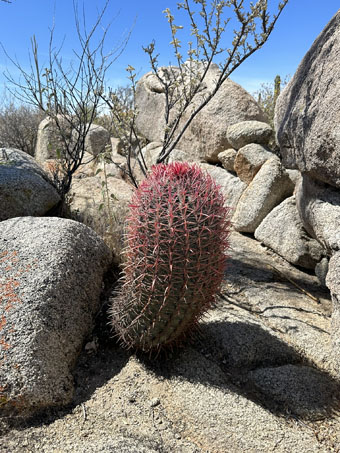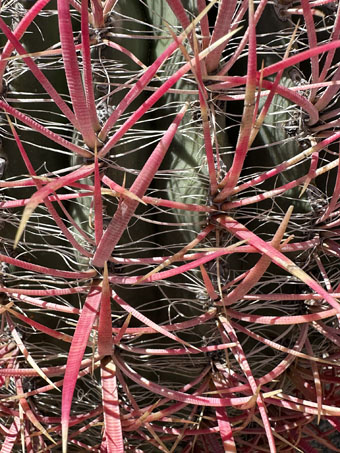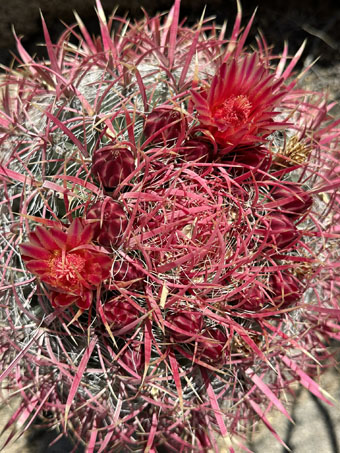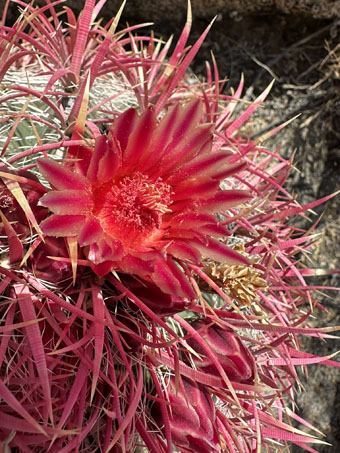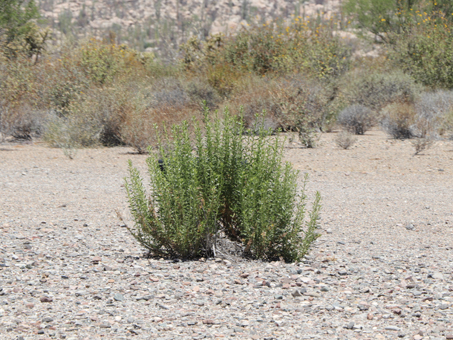This section contains entries about our botanizing in Baja California written for the UC BEE (Oct 2012 to Aug 2021)
and The UC Hive (2022-), monthly newsletters for volunteers and staff of the UC Berkeley Botanical Garden.
Click on any photo for a larger image.
THE HIVE APR 2025
Central Desert — June 2024
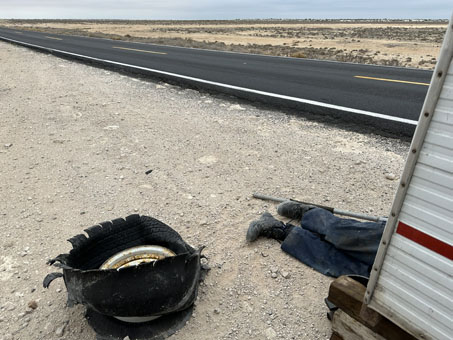 I got off to a shaky start on my trip north. On my second day, minutes after I had headed out of Guerrero Negro for Cataviña, a tire on the utility trailer exploded. I spent most of the late morning and afternoon on the side of the highway just a few miles north of my friend's hotelito, waiting for a couple of hours while a llantero worked first on loosening the rusty lug nuts on the wheel and hacking off the broken leaf spring that was revealed once the tire was off and then waiting another couple of hours while he returned to town to locate a new tire and spring and then comeback to install them.
I got off to a shaky start on my trip north. On my second day, minutes after I had headed out of Guerrero Negro for Cataviña, a tire on the utility trailer exploded. I spent most of the late morning and afternoon on the side of the highway just a few miles north of my friend's hotelito, waiting for a couple of hours while a llantero worked first on loosening the rusty lug nuts on the wheel and hacking off the broken leaf spring that was revealed once the tire was off and then waiting another couple of hours while he returned to town to locate a new tire and spring and then comeback to install them.
The road was in bad shape between Mulegé and Guerrero Negro and recent road conditions reported that it was in even worse condition north of there, at least as far as the Hwy 5 turnoff to San Felipe. I decided late that afternoon that there was not enough daylight left to make the 3+ hr drive to Cataviña, so I ended up turning back to my friend's.
When I next set out north a few days later, my nerves were recovered after a good rest, which was good because I ended up needing them. I figure that there were long stretches that day where I was lucky to have averaged 30 mph. There were places I crept along between 2 and10 mph because the potholes covered much of the highway on both sides and/or there was oncoming traffic, especially a lot of semi-trailers, that made it impossible to slalom to better parts of the road.
After the experience a few days earlier, I was super vigilant and cautious. Under good road conditions, that leg usually takes us about 2.5 hours, but this time, it was about 6 hours, some of that extra time because (of course) I had to pull over to look at plants and enjoy the scenery.
For previous entries and articles about Cataviña and Baja California (norte) plants and scenery see these:
Jul 2019, Jun 2019, Baja Norte, Catavina plants.
Valle de los Cirios
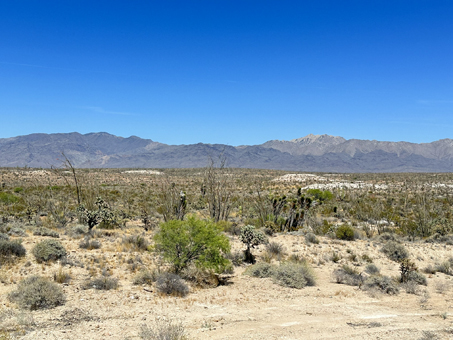
Typical landscape between Punta Prieta and Laguna Chapala. Many shrubs and trees were leafy and some where showing signs of impending spring flowers. However, typical herbs were dry or absent.
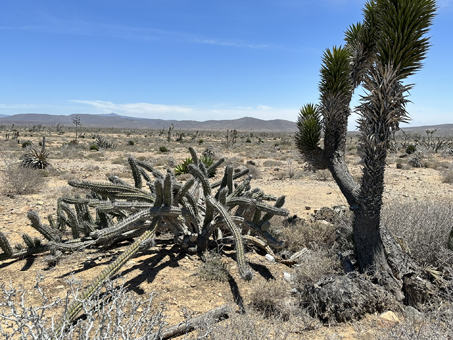
Along the ecotone of desert & coastal scrub, it was very dry. Many drought-deciduous shrubs & trees were leafless. Cacti like Galloping Cactus (Stenocereus gummosus) & Datilillo (Yucca valida) looked alive.

Cliff Spurge (Euphorbia misera) with a fruticose lichen. In the shadow of the branch at right there are also black spots visible in the bark, another lichen species.
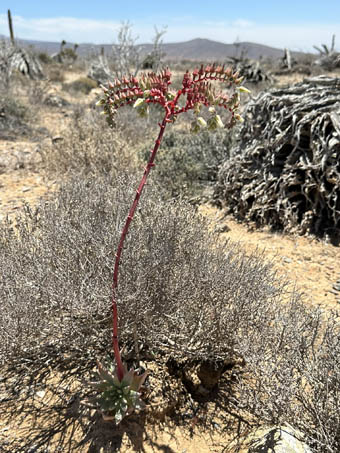
White-flower Liveforever (Dudleya albiflora), one of several peninsular endemics in this region. It is found mainly along the western part of the peninsula.
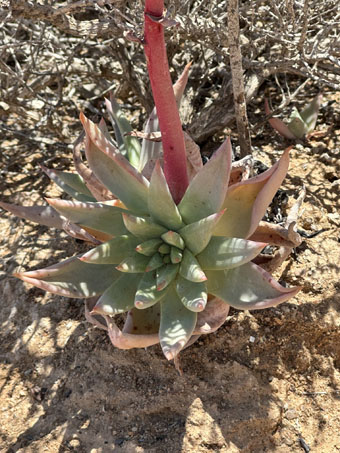
The leaves and rosette resemble D. attenuata in size & shape, but the flower color is distinctive.
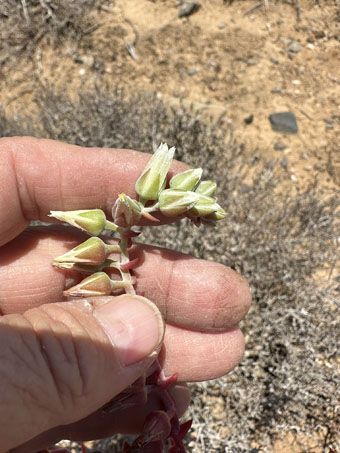
The flowers of White-flower Liveforever are about 1 cm L. Herbage is glaucous.
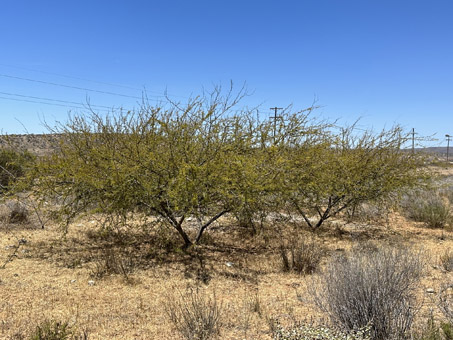
Sweet Acacia (Vachellia farnesiana var. farnesiana) is a common & widespread shrub or tree found from Central BC to the Cape region.

Sweet Acacia has feathery, compound pinnate leaves with 2-6 pinnae & 10-25 pairs of leaflets. The branches have a zig-zag appearance.
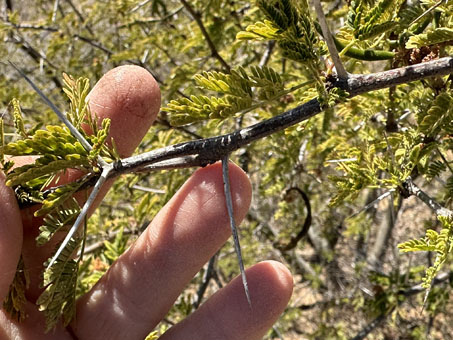
Sweet Acacia is well-armed with long, pale, straight spines 2.5-5 cm .
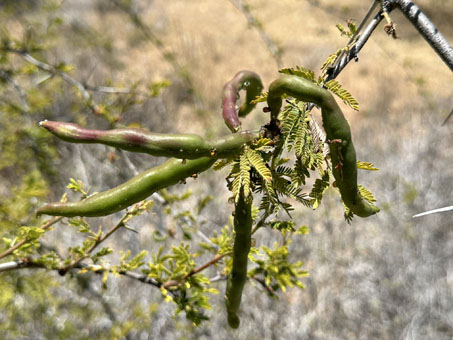
Flowers are in bright yellow, capitate heads and the often numerous fruit pods are c. 5-7.5 cm L and become purplish-brown with age.
Cataviña Boulder Fields — Rancho Santa Inés
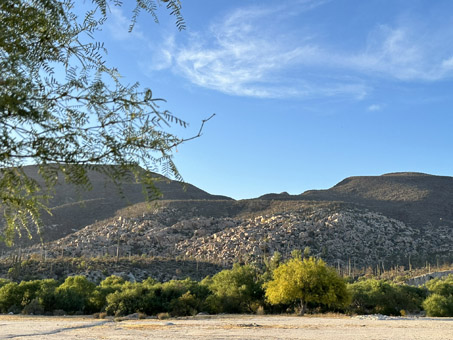
Rancho Santa Inés is located just south of the town of Cataviña. The campground is located just above an arroyo with lots of boulders nearby.
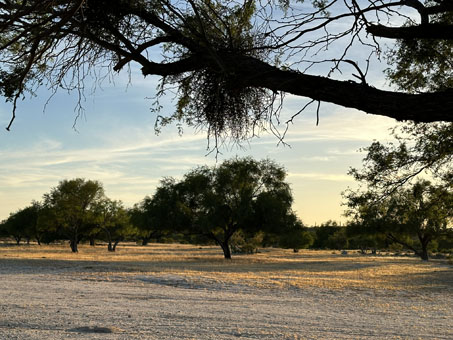
These trees look a lot like Oak trees in Central California but they are actually enormous Honey Mesquites (Neltuma odorata; previously Prosopis torreyana var. glandulosa). Small RVs can fit under some.

Just a hundred meters from camp I was happily in the botanically-rich boulder fields. There are many clear paths between boulders.
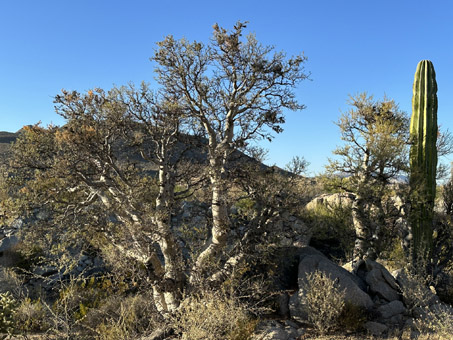
I spent two days at the ranch and documented and photographed 48 vascular plant taxa and at least two moss and five lichen taxa.
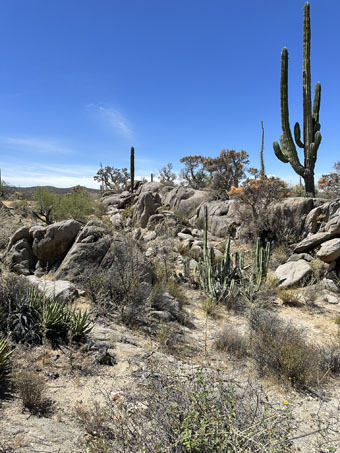
Major species include Boojums, Ocotillos, Elephant Trees, Cardóns, Old-man Cactus, Chollas, and numerous shrubby composites.
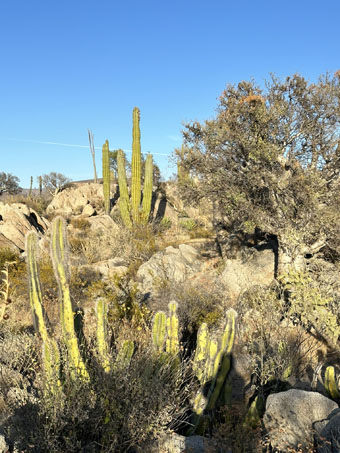
Old-man Cactus (Lophocereus schottii, front), Elephant Tree (Pachycormus discolor var. pubescens, top R) and Cardón (Pachycereus pringlei, top center).
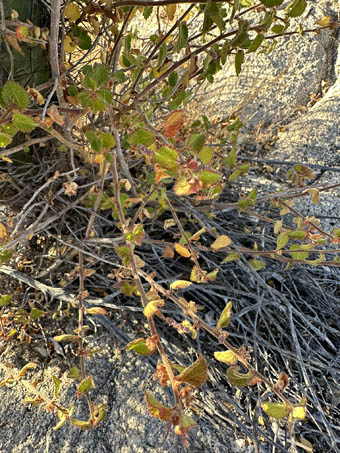
Copper Leaf (Acalypha californica) is abundant among the boulders. The small, mostly open shrub has soft, fuzzy leaves with red, toothed margins.
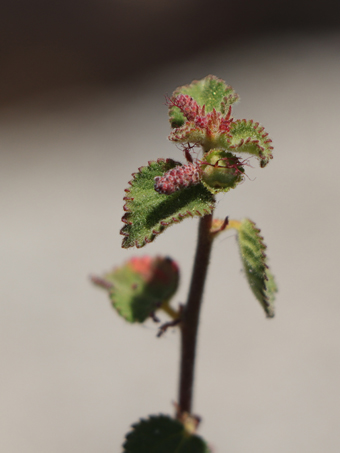
Leaves turn coppery with age. Staminate flowers are in racemes c. 1 cm L. A pistillate flower is located at the base of each raceme. Flowers lack petals.
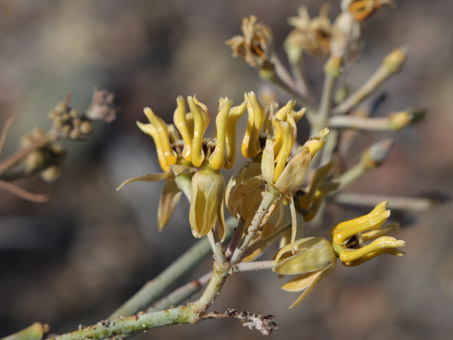
Rush Milkweed (Asclepias subulata) is common in disturbed soils, especially along the edge of roads and in arroyos. Flowers are c. 1 cm D and arranged in a cyme on mostly bare stems.
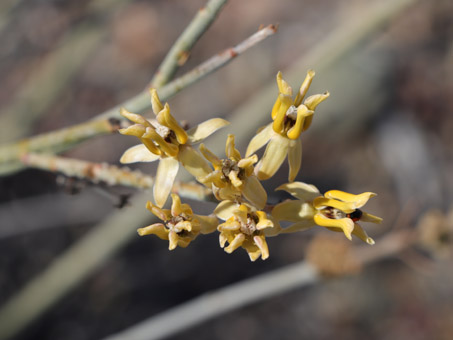
Rush Milkweed has ephemeral filiform leaves. The fruit is a follicle c. 5-8 cm L. At maturity, it splits longitudinally to release numerous seeds each with a cottony parachute.
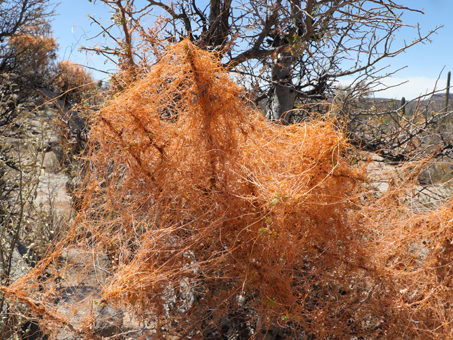
A common sight in the Central Desert are these bright orange web-like growths of Elephant Tree Dodder, a parasitic vine growing on Baja California Elephant Trees.
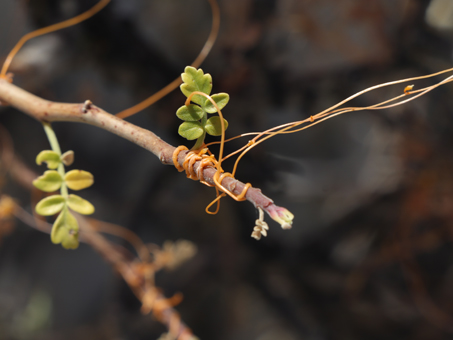
The filiform haustoria of Elephant Tree Dodder (Cuscuta veatchii) on a Baja California Elephant Tree (Pachycormus discolor var. pubescens). Both plants are endemic.
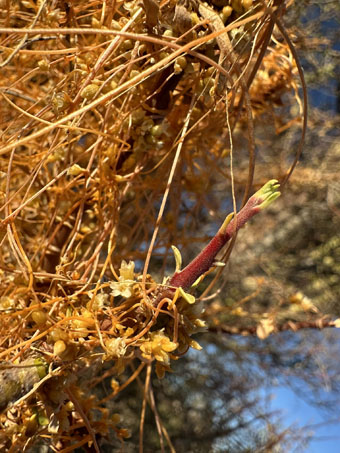
A few tiny flowers (3-4 mm W) and flower buds of Cuscuta veatchii are visible in this mass of haustoria.
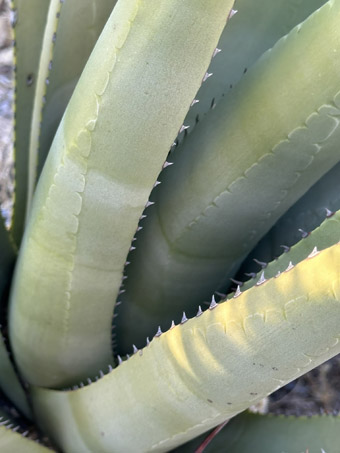
A closeup view of the teeth and striations on the leaves of Desert Agave (Agave desertii var. desertii).
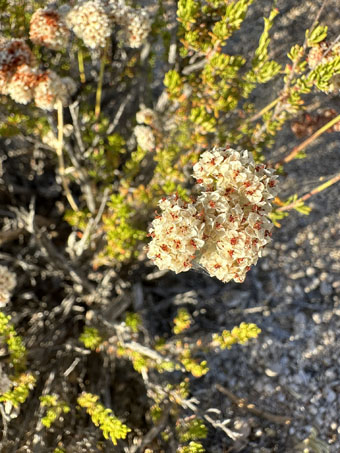
Sonoran Desert California Buckwheat (Eriogonum fasciculata var. flavoviride) is a common shrub in the Central Desert. White flowers are tinged pink. The dense short leaves are needle-like or slightly flattened. Old heads are rusty-red.
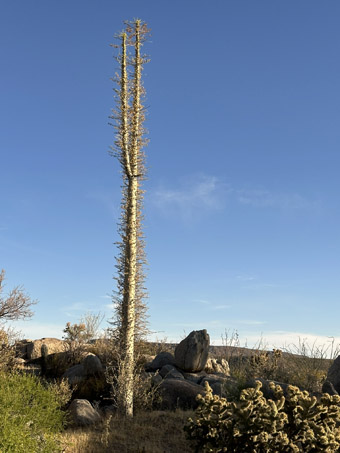
A Boojum Tree (Fouquieria columnaris) is not a tree but a shrub related to Ocotillo. This plant is c. 6-7 m H. The short, stiff ± horizontal branches give it an overall fuzzy look while branching of the upper stem can, often give these shrubs a fantastical appearance.
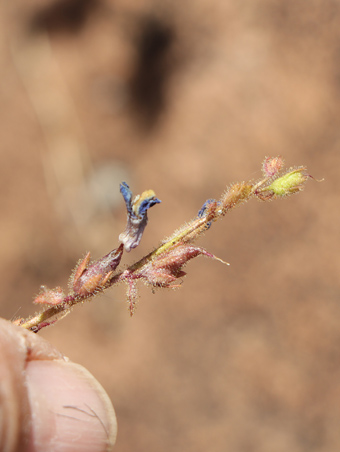
A new observation for me: likely the herbaceous Big-Gland Nuttall Snapdragon (Sairocarpus pusillus), a small, uncommon native subspecies c. 30 cm H.
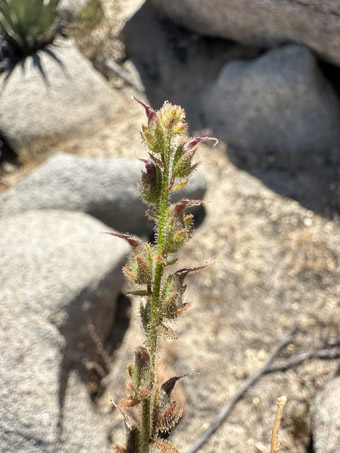
The herbage of Sairocarpus pusillus is sticky. The beaked capsules are c. 1 cm L. It occurs from near the international border south to the Sierra Giganta.
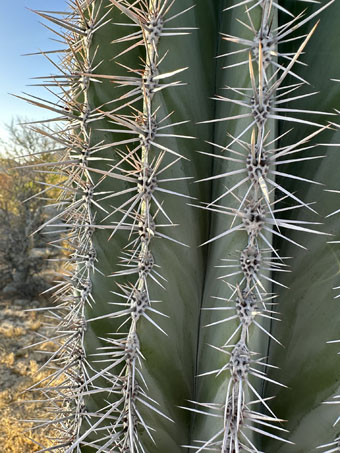
Spines and chevron striations of a youngish Cardón.
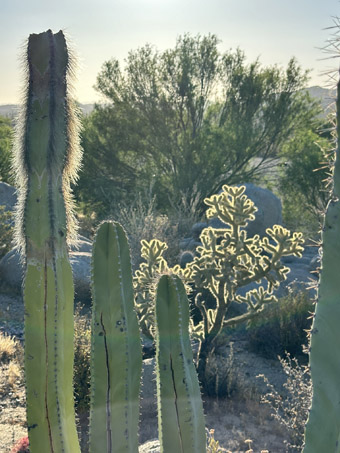
Old-man Cactus (front) and Cholla (Cylindropuntia).
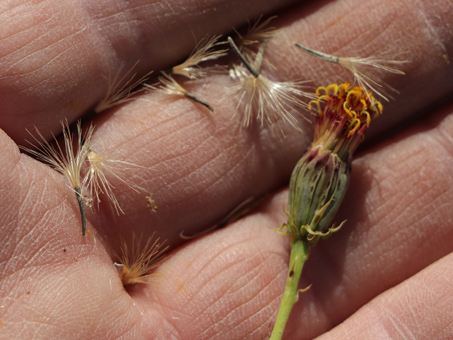
San Felipe Dogweed (Adenophyllum porophylloides) is a widespread but not particularly abundant species that occurs from the San Felipe Desert south into northern BCS. The herbage is quite pungent.
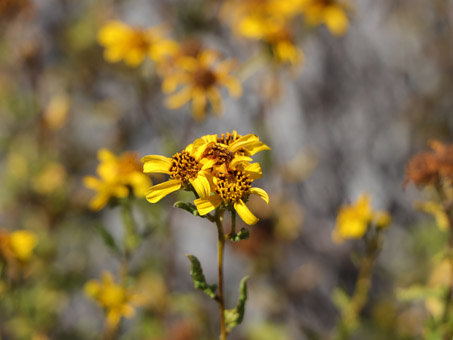
San Diego Sunflower (Bahiopsis laciniata) is a common and abundant native shrub that is almost a near endemic to the state of BC. Flowers are about 2 cm D.
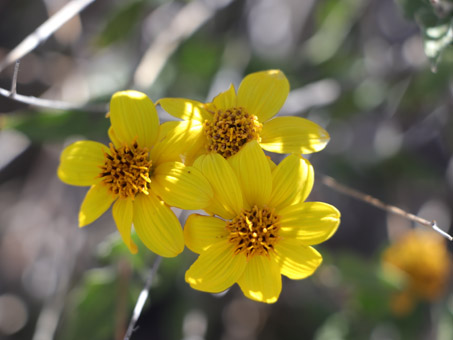
Baja California Goldeneye (Bahiopsis triangularis) is common from northern BC to mid BCS. Flowers are 2.5-3 cm D.
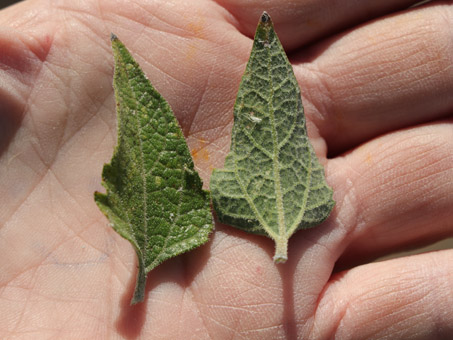
The leaves of Baja California Goldeneye are somewhat coriaceous and very raspy. They can reach 7-8 cm L.

Desert Alkali Goldenbush leaves and old flower heads.
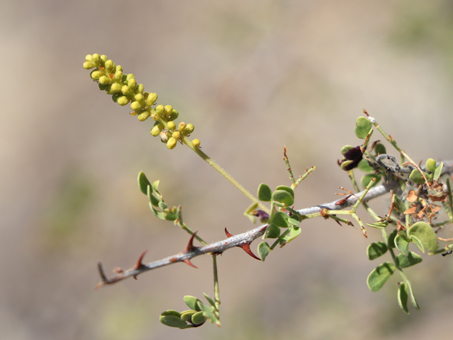
Cat-claw Acacia (Senegalia greggii) is a medium to large shrub widespread in the Central Desert northward and into the southern US.
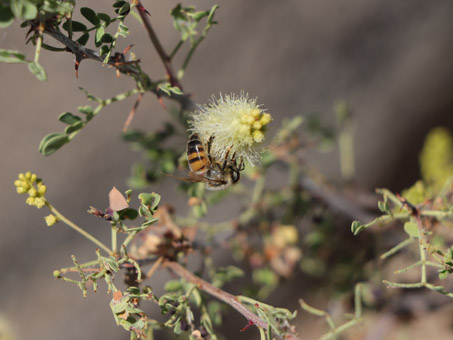
Bee on a Cat-claw Acacia inflorescence.
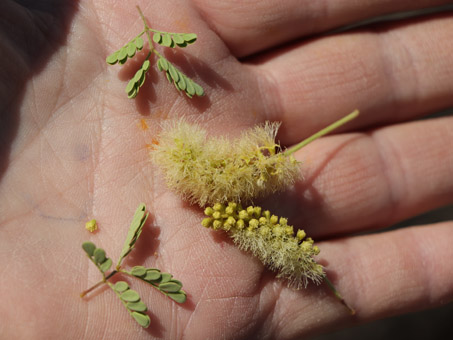
The compound leaf and inflorescenses of Cat-claw Acacia.
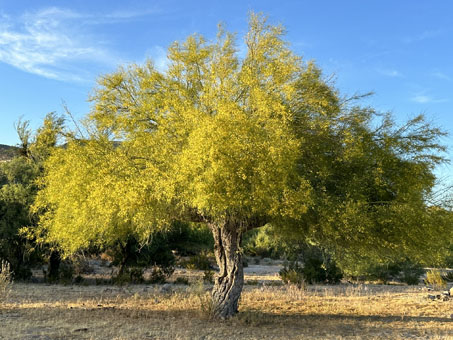
A beautiful old Mexican Palo Verde (Parkinsonia aculeata).

Mexican Palo Verde usually has a green trunk to the ground but this is an old specimen.
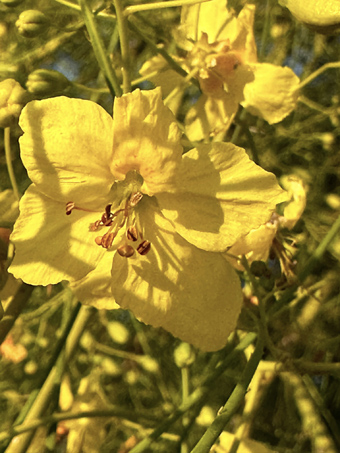
The flowers of Mexican Palo Verde are about 2 cm D. The banner turns orange to maroon when pollinated.
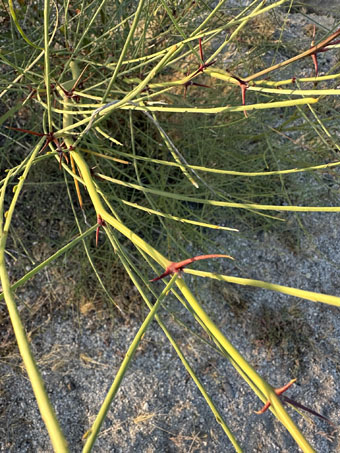
Stems and leaves of Mexican Palo Verde. Two or three long, very sharp spines are present at the nodes.
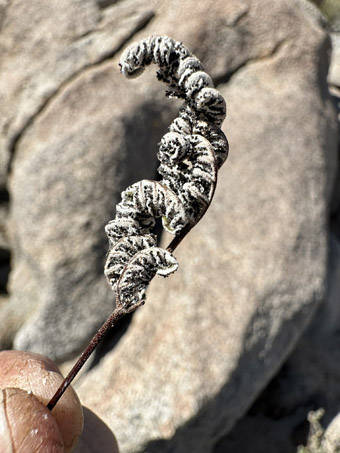
Dessicated frond of White-Blade California Cloak Fern (Notholaena californica subsp. leucophylla). Note the white farina on the underside. I recently wrote about this & other fern genera that can be rehydrated.
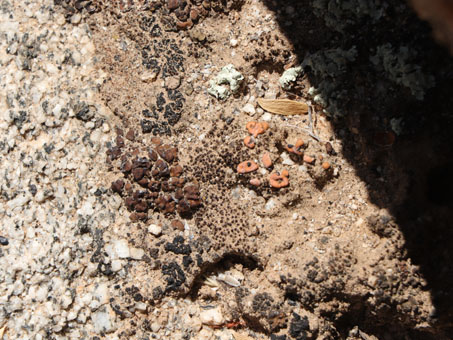
Two to three lichen species. The tiny black dots between them are the moss Didymodon australasiae, one of 4 species I collected.
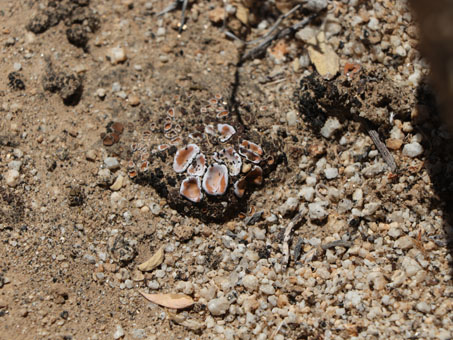
Crenate fishscale lichen (Psora crenata, orangish discss at center) with other small patches of lichen and moss.

Appears to be a Green Shield Lichen (in Parmelioideae subfamily).
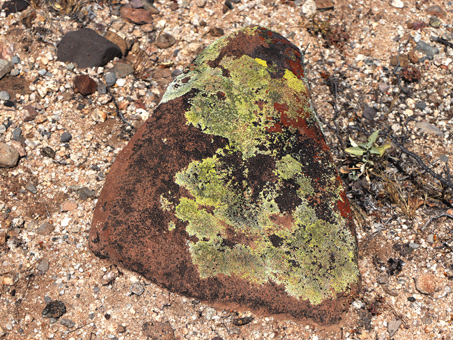
A rock with several different lichen species. My only image of this.
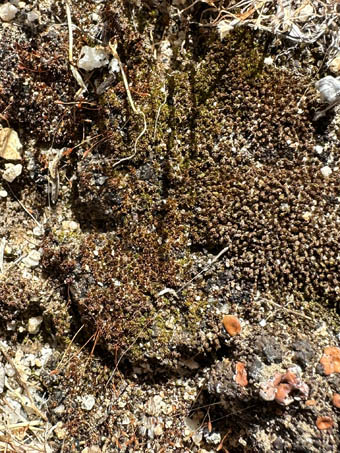
Another desert moss, Grimmia moxleyi with a few orange thalli of Fishscale lichen. This species is endemic to sw US and nw Mexico.
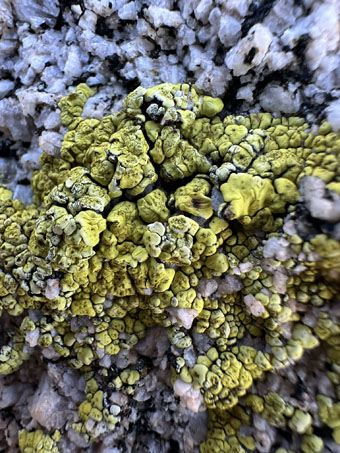
This yellowish green lichen is likely Yellow Cobblestone Lichen (Acaraspora socialis), a common and widespread species in western North America.

Looks like two different species growing on granitic rock, the reddish-orange Rock Jewel Lichen (Calogaya saxicola) and an unknown black lichen.
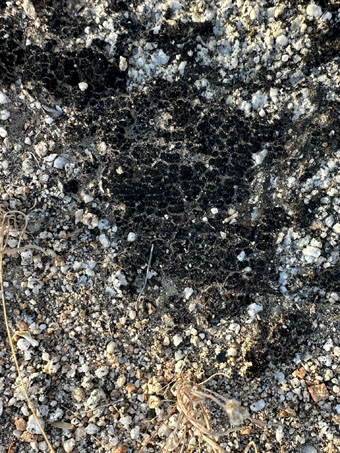
Another unidentified black lichen growing on rotted granitic soil.
We have reached the end of another entry. The season is flying by and soon I hope to spend three or four days camping at Rancho Santa Inés on my next trip north and be able to explore the area at a more leisurely pace. But meanwhile, next month I will write about the geology/plant walk I collaborated on at Punta Chivato last month. So until then, Hasta pronto...see you soon.
Debra Valov — Curatorial Volunteer
For a full inventory list of this month's plants and other organisms (family, latin name and common names in both English and Spanish as well as links to photos from previous posts or my iNaturalist observations), visit this page.
For previous entries about Cataviña and Baja California scenery see these entries: Jul 2019, Jun 2019, Baja Norte, Cataviña plants.
References and Literature Cited
Greven, H.C. (2014). Grimmias of the World: Guide to the moss genus Grimmia Hedw.. Grimmia moxleyi available at: https://grimmiasoftheworld.com/pdf/Grimmia_moxleyi.pdf
Rebman, J. P., J. Gibson, and K. Rich, 2016. Annotated checklist of the vascular plants of Baja California, Mexico. Proceedings of the San Diego Society of Natural History, No. 45, 15 November 2016. San Diego Natural History Museum, San Diego, CA. Full text available online.
Rebman, J. P and Roberts, N. C. (2012). Baja California Plant Field Guide. San Diego, CA: Sunbelt Publications. Descriptions and distribution.
Valov, D. (2020). An Annotated Checklist of the Vascular Plants of Mulegé, Baja California, Mexico. Madroño 67(3), 115-160, (23 December 2020). https://doi.org/10.3120/0024-9637-67.3.115
Wiggins, I. L. (1980). The Flora of Baja California. Stanford University Press. Keys and descriptions.


 I got off to a shaky start on my trip north. On my second day, minutes after I had headed out of Guerrero Negro for Cataviña, a tire on the utility trailer exploded. I spent most of the late morning and afternoon on the side of the highway just a few miles north of my friend's
I got off to a shaky start on my trip north. On my second day, minutes after I had headed out of Guerrero Negro for Cataviña, a tire on the utility trailer exploded. I spent most of the late morning and afternoon on the side of the highway just a few miles north of my friend's 





























